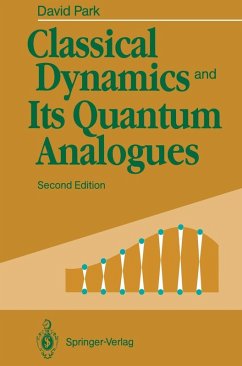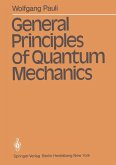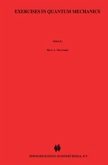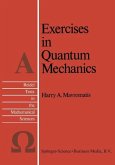David Park
Classical Dynamics and Its Quantum Analogues (eBook, PDF)
88,95 €
88,95 €
inkl. MwSt.
Sofort per Download lieferbar

44 °P sammeln
88,95 €
Als Download kaufen

88,95 €
inkl. MwSt.
Sofort per Download lieferbar

44 °P sammeln
Jetzt verschenken
Alle Infos zum eBook verschenken
88,95 €
inkl. MwSt.
Sofort per Download lieferbar
Alle Infos zum eBook verschenken

44 °P sammeln
David Park
Classical Dynamics and Its Quantum Analogues (eBook, PDF)
- Format: PDF
- Merkliste
- Auf die Merkliste
- Bewerten Bewerten
- Teilen
- Produkt teilen
- Produkterinnerung
- Produkterinnerung

Bitte loggen Sie sich zunächst in Ihr Kundenkonto ein oder registrieren Sie sich bei
bücher.de, um das eBook-Abo tolino select nutzen zu können.
Hier können Sie sich einloggen
Hier können Sie sich einloggen
Sie sind bereits eingeloggt. Klicken Sie auf 2. tolino select Abo, um fortzufahren.

Bitte loggen Sie sich zunächst in Ihr Kundenkonto ein oder registrieren Sie sich bei bücher.de, um das eBook-Abo tolino select nutzen zu können.
A text in the classical dynamics of particles, rigid bodies, and continuous systems and corresponding aspects of quantum mechanics, emphasizing the connections and continuity between these two theories. Together with traditional topics it treats such matters as chaotic nonlinear dynamics and the difference between classical and quantum theories of continuous fields.
- Geräte: PC
- ohne Kopierschutz
- eBook Hilfe
- Größe: 38.67MB
Andere Kunden interessierten sich auch für
![General Principles of Quantum Mechanics (eBook, PDF) General Principles of Quantum Mechanics (eBook, PDF)]() Wolfgang PauliGeneral Principles of Quantum Mechanics (eBook, PDF)104,95 €
Wolfgang PauliGeneral Principles of Quantum Mechanics (eBook, PDF)104,95 €![Quantum Theory of Many-Body Systems (eBook, PDF) Quantum Theory of Many-Body Systems (eBook, PDF)]() Alexandre ZagoskinQuantum Theory of Many-Body Systems (eBook, PDF)40,95 €
Alexandre ZagoskinQuantum Theory of Many-Body Systems (eBook, PDF)40,95 €![Classical and Quantum Mechanics of Noncentral Potentials (eBook, PDF) Classical and Quantum Mechanics of Noncentral Potentials (eBook, PDF)]() Radhey S. KaushalClassical and Quantum Mechanics of Noncentral Potentials (eBook, PDF)40,95 €
Radhey S. KaushalClassical and Quantum Mechanics of Noncentral Potentials (eBook, PDF)40,95 €![Theoretical Physics (eBook, PDF) Theoretical Physics (eBook, PDF)]() Josef HonerkampTheoretical Physics (eBook, PDF)72,95 €
Josef HonerkampTheoretical Physics (eBook, PDF)72,95 €![Quantum Mechanics (eBook, PDF) Quantum Mechanics (eBook, PDF)]() Bruce Cameron ReedQuantum Mechanics (eBook, PDF)52,95 €
Bruce Cameron ReedQuantum Mechanics (eBook, PDF)52,95 €![Exercises in Quantum Mechanics (eBook, PDF) Exercises in Quantum Mechanics (eBook, PDF)]() H. A. MavromatisExercises in Quantum Mechanics (eBook, PDF)112,95 €
H. A. MavromatisExercises in Quantum Mechanics (eBook, PDF)112,95 €![Exercises in Quantum Mechanics (eBook, PDF) Exercises in Quantum Mechanics (eBook, PDF)]() H. A. MavromatisExercises in Quantum Mechanics (eBook, PDF)40,95 €
H. A. MavromatisExercises in Quantum Mechanics (eBook, PDF)40,95 €-
-
-
A text in the classical dynamics of particles, rigid bodies, and continuous systems and corresponding aspects of quantum mechanics, emphasizing the connections and continuity between these two theories. Together with traditional topics it treats such matters as chaotic nonlinear dynamics and the difference between classical and quantum theories of continuous fields.
Dieser Download kann aus rechtlichen Gründen nur mit Rechnungsadresse in A, B, BG, CY, CZ, D, DK, EW, E, FIN, F, GR, HR, H, IRL, I, LT, L, LR, M, NL, PL, P, R, S, SLO, SK ausgeliefert werden.
Produktdetails
- Produktdetails
- Verlag: Springer Berlin Heidelberg
- Seitenzahl: 333
- Erscheinungstermin: 6. Dezember 2012
- Englisch
- ISBN-13: 9783642749223
- Artikelnr.: 53291792
- Verlag: Springer Berlin Heidelberg
- Seitenzahl: 333
- Erscheinungstermin: 6. Dezember 2012
- Englisch
- ISBN-13: 9783642749223
- Artikelnr.: 53291792
- Herstellerkennzeichnung Die Herstellerinformationen sind derzeit nicht verfügbar.
1. Rays of Light.- 1.1 Waves, Rays, and Orbits.- 1.2 Phase Velocity and Group Velocity.- 1.3 Dynamics of a Wave Packet.- 1.4 Fermat's Principle of Least Time.- 1.5 Interlude on the Calculus of Variations.- 1.6 Optics in a Gravitational Field.- 2. Orbits of Particles.- 2.1 Ehrenfest's Theorems.- 2.2 Oscillators and Pendulums.- 2.3 Interlude on Elliptic Functions.- 2.4 Driven Oscillators.- 2.5 A Driven Anharmonic Oscillator.- 2.6 Quantized Oscillators.- 2.7 Coherent States.- 3. Lagrangian Dynamics.- 3.1 Lagrange's Equations.- 3.2 The Double Pendulum.- 3.3 Planets and Atoms.- 3.4 Orbital Oscillations and Stability.- 3.5 Orbital Motion: Vectorial Integrals and Hyperbolic Orbits.- 3.6 Other Forces.- 3.7 Bohr Orbits and Quantum Mechanics: Degeneracy.- 3.8 The Principle of Maupertuis and Its Practical Utility.- 4. N-Particle Systems.- 4.1 Center-of-Mass Theorems.- 4.2 Two-Particle Systems.- 4.3 Vibrating Systems.- 4.4 Coupled Oscillators.- 4.5 The Virial Theorem.- 4.6 Hydrodynamics.- 5. Hamiltonian Dynamics.- 5.1 The Canonical Equations.- 5.2 Magnetic Forces.- 5.3 Canonical Transformations.- 5.4 Infinitesimal Transformations.- 5.5 Generating Finite Transformations from Infinitesimal Ones.- 5.6 Deduction of New Integrals.- 5.7 Commutators and Poisson Brackets.- 5.8 Gauge Invariance.- 6. The Hamilton-Jacobi Theory.- 6.1 The Hamilton-Jacobi Equation.- 6.2 Step-by-Step Integration of the Hamilton-Jacobi Equation.- 6.3 Interlude on Planetary Motion in General Relativity.- 6.4 Jacobi's Generalization.- 6.5 Orbits and Integrals.- 6.6 "Chaos".- 6.7 Coordinate Systems.- 6.8 Curvilinear Coordinates.- 6.9 Interlude on Classical Optics.- 7. Action and Phase.- 7.1 The Old Quantum Theory.- 7.2 Hydrogen Atom in the Old Quantum Theory.- 7.3 The Adiabatic Theorem.- 7.4 Connectionswith Quantum Mechanics.- 7.5 Heisenberg's Quantum Mechanics.- 7.6 Matter Waves.- 7.7 Schrödinger's "Derivation".- 7.8 Construction of a Wave Function.- 7.9 Phase Shifts in Dynamics.- 8. Theory of Perturbations.- 8.1 Secular and Periodic Perturbations.- 8.2 Perturbations in Quantum Mechanics.- 8.3 Adiabatic Perturbations.- 8.4 Degenerate States.- 8.5 Quantum Perturbation Theory for Positive-Energy States.- 8.6 Action and Angle Variables.- 8.7 Canonical Perturbation Theory.- 8.8 Newtonian Precession.- 9. The Motion of a Rigid Body.- 9.1 Angular Velocity and Momentum.- 9.2 The Inertia Tensor.- 9.3 Dynamics in a Rotating Coordinate System.- 9.4 Euler's Equations.- 9.5 The Precession of the Equinoxes.- 9.6 Quantum Mechanics of a Rigid Body.- 9.7 Spinors.- 9.8 Particles with Spin.- 10. Continuous Systems.- 10.1 Stretched Strings.- 10.2 Four Modes of Description.- 10.3 Example: A Plucked String.- 10.4 Practical Use of Variation Principles.- 10.5 More Than One Dimension.- 10.6 Waves in Space.- 10.7 The Matter Field.- 10.8 Quantized Fields.- 10.9 The Mössbauer Effect.- 10.10 Classical and Quantum Descriptions of Nature.- References.- Notation.
1. Rays of Light.- 1.1 Waves, Rays, and Orbits.- 1.2 Phase Velocity and Group Velocity.- 1.3 Dynamics of a Wave Packet.- 1.4 Fermat's Principle of Least Time.- 1.5 Interlude on the Calculus of Variations.- 1.6 Optics in a Gravitational Field.- 2. Orbits of Particles.- 2.1 Ehrenfest's Theorems.- 2.2 Oscillators and Pendulums.- 2.3 Interlude on Elliptic Functions.- 2.4 Driven Oscillators.- 2.5 A Driven Anharmonic Oscillator.- 2.6 Quantized Oscillators.- 2.7 Coherent States.- 3. Lagrangian Dynamics.- 3.1 Lagrange's Equations.- 3.2 The Double Pendulum.- 3.3 Planets and Atoms.- 3.4 Orbital Oscillations and Stability.- 3.5 Orbital Motion: Vectorial Integrals and Hyperbolic Orbits.- 3.6 Other Forces.- 3.7 Bohr Orbits and Quantum Mechanics: Degeneracy.- 3.8 The Principle of Maupertuis and Its Practical Utility.- 4. N-Particle Systems.- 4.1 Center-of-Mass Theorems.- 4.2 Two-Particle Systems.- 4.3 Vibrating Systems.- 4.4 Coupled Oscillators.- 4.5 The Virial Theorem.- 4.6 Hydrodynamics.- 5. Hamiltonian Dynamics.- 5.1 The Canonical Equations.- 5.2 Magnetic Forces.- 5.3 Canonical Transformations.- 5.4 Infinitesimal Transformations.- 5.5 Generating Finite Transformations from Infinitesimal Ones.- 5.6 Deduction of New Integrals.- 5.7 Commutators and Poisson Brackets.- 5.8 Gauge Invariance.- 6. The Hamilton-Jacobi Theory.- 6.1 The Hamilton-Jacobi Equation.- 6.2 Step-by-Step Integration of the Hamilton-Jacobi Equation.- 6.3 Interlude on Planetary Motion in General Relativity.- 6.4 Jacobi's Generalization.- 6.5 Orbits and Integrals.- 6.6 "Chaos".- 6.7 Coordinate Systems.- 6.8 Curvilinear Coordinates.- 6.9 Interlude on Classical Optics.- 7. Action and Phase.- 7.1 The Old Quantum Theory.- 7.2 Hydrogen Atom in the Old Quantum Theory.- 7.3 The Adiabatic Theorem.- 7.4 Connectionswith Quantum Mechanics.- 7.5 Heisenberg's Quantum Mechanics.- 7.6 Matter Waves.- 7.7 Schrödinger's "Derivation".- 7.8 Construction of a Wave Function.- 7.9 Phase Shifts in Dynamics.- 8. Theory of Perturbations.- 8.1 Secular and Periodic Perturbations.- 8.2 Perturbations in Quantum Mechanics.- 8.3 Adiabatic Perturbations.- 8.4 Degenerate States.- 8.5 Quantum Perturbation Theory for Positive-Energy States.- 8.6 Action and Angle Variables.- 8.7 Canonical Perturbation Theory.- 8.8 Newtonian Precession.- 9. The Motion of a Rigid Body.- 9.1 Angular Velocity and Momentum.- 9.2 The Inertia Tensor.- 9.3 Dynamics in a Rotating Coordinate System.- 9.4 Euler's Equations.- 9.5 The Precession of the Equinoxes.- 9.6 Quantum Mechanics of a Rigid Body.- 9.7 Spinors.- 9.8 Particles with Spin.- 10. Continuous Systems.- 10.1 Stretched Strings.- 10.2 Four Modes of Description.- 10.3 Example: A Plucked String.- 10.4 Practical Use of Variation Principles.- 10.5 More Than One Dimension.- 10.6 Waves in Space.- 10.7 The Matter Field.- 10.8 Quantized Fields.- 10.9 The Mössbauer Effect.- 10.10 Classical and Quantum Descriptions of Nature.- References.- Notation.







